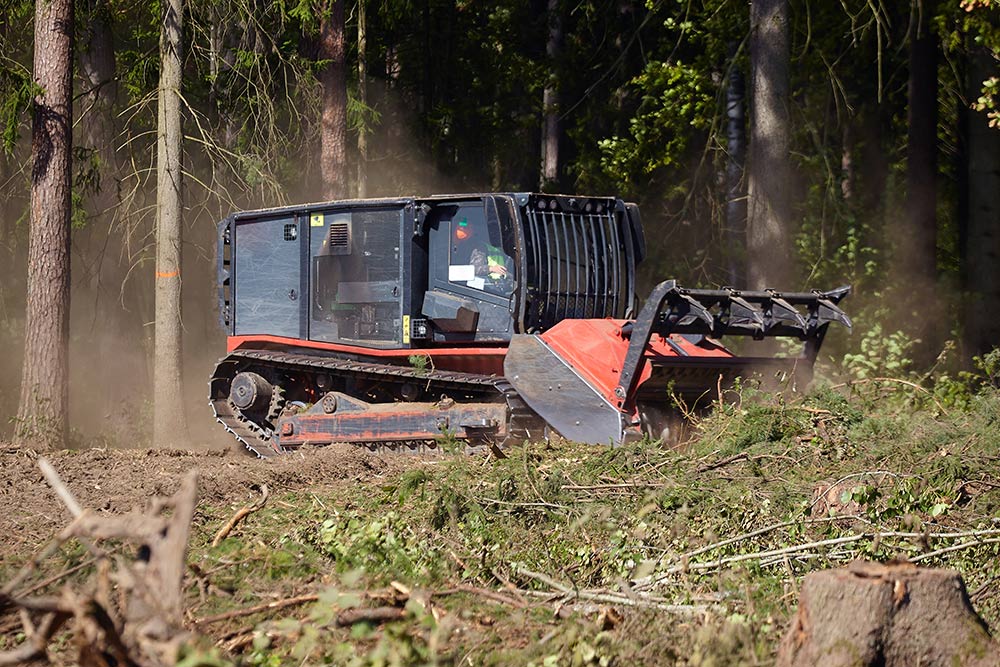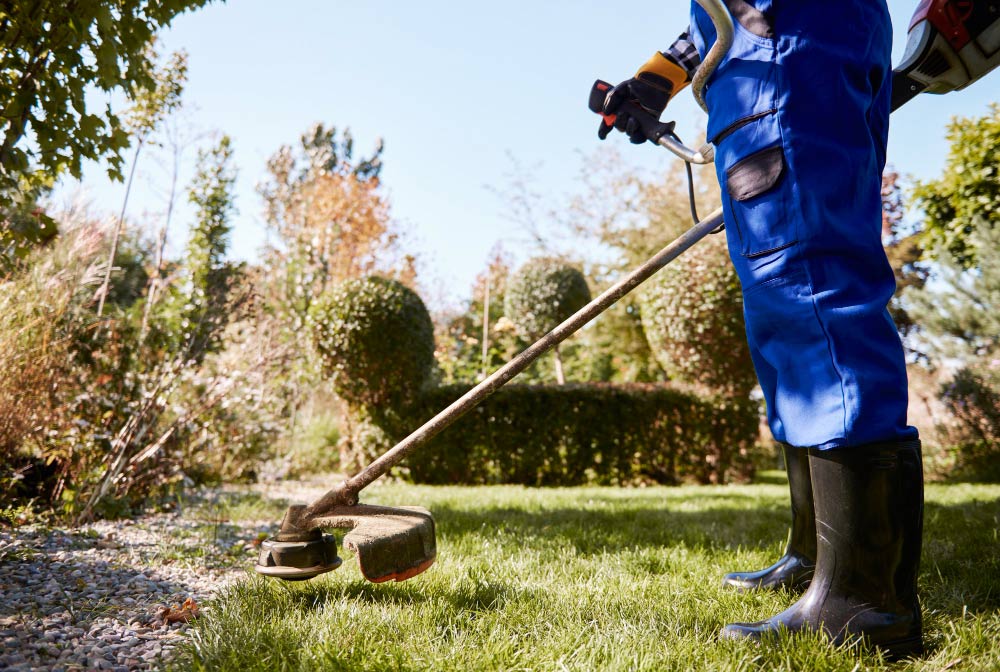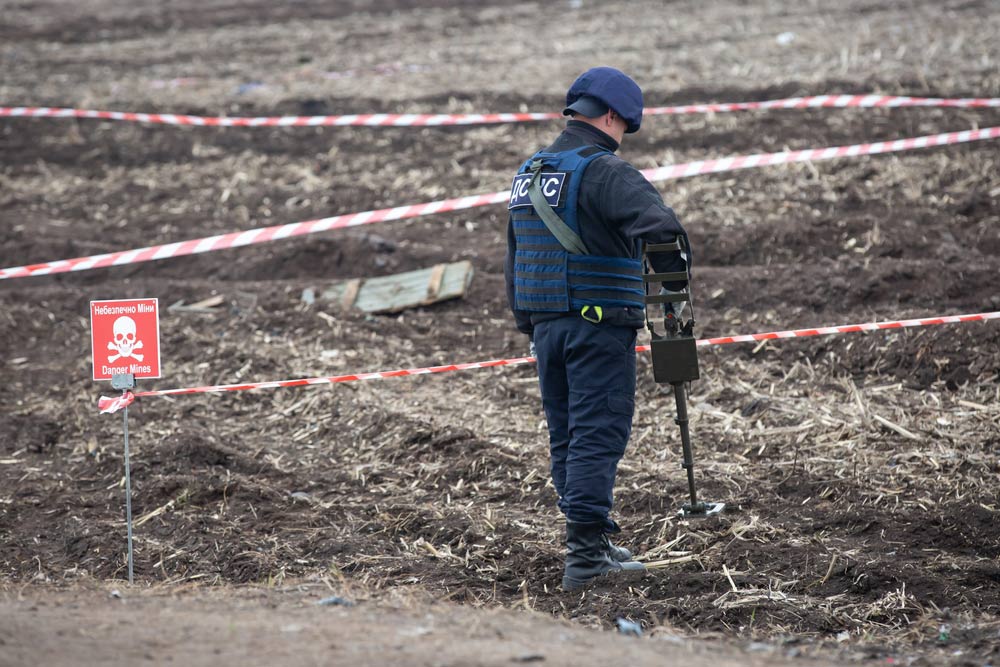Military installations and high-security facilities require continuous vegetation control to ensure clear sightlines, maintain secure perimeters, and enable rapid operational response. These areas can include bases, training grounds, border zones, and critical infrastructure sites where vegetation overgrowth can obstruct visibility, create hiding spots, or interfere with surveillance systems.
The stakes are high, as security is not only about deterrence but also about ensuring that personnel, equipment, and infrastructure remain protected at all times. Heavy-duty mulchers provide a fast, precise, and environmentally responsible solution for clearing large areas, maintaining defensive perimeters, and supporting mission readiness without compromising environmental stewardship.

In high-security environments such as military bases, correctional facilities, border control zones, and strategic infrastructure sites, vegetation management is not just about aesthetics or basic maintenance — it is a core part of the security strategy. Unchecked vegetation can create serious vulnerabilities that compromise both safety and operational readiness. Overgrown brush and tall grass near fences, access roads, or surveillance points can provide concealment for intruders, obscure visibility for guards and cameras, and physically block patrol vehicles or personnel.
In addition, thick vegetation can create interference for sensitive equipment such as motion sensors, infrared detection systems, and perimeter alarms, leading to false alerts or reduced efficiency. In training zones, especially those designed for live-fire drills, tactical maneuvers, or vehicle exercises, unmanaged plant growth can reduce usable space, limit line-of-sight for instructors, and even present tripping or collision hazards.
Strategic vegetation control with heavy-duty mulchers ensures that security environments remain fully operational, visible, and accessible throughout the year, regardless of seasonal growth patterns or challenging terrain. This proactive approach not only strengthens physical security but also extends the lifespan of infrastructure and reduces long-term maintenance costs.
These same operational principles are common in utility corridor clearing where uninterrupted access is critical.
A secure perimeter is only as strong as its weakest point, and unmanaged vegetation often becomes that weakness. Fences, barriers, and walls lose much of their effectiveness if the surrounding areas are overgrown. Tall grass and brush can serve as natural camouflage for intruders attempting to approach unnoticed, while tree branches or climbing plants can physically aid in scaling barriers.
Heavy-duty mulchers allow security teams to eliminate these risks quickly and efficiently, processing vegetation in place so that clear zones are maintained without leaving piles of debris that could be repurposed for cover. This ensures that lines of sight are completely unobstructed for both human guards and technological surveillance systems.
Key benefits of maintaining clear perimeters and sightlines with mulchers include:
By keeping perimeters consistently clear, security personnel can detect movement at greater distances, respond to threats more quickly, and maintain uninterrupted surveillance coverage. This not only strengthens day-to-day security but also acts as a powerful deterrent against attempted breaches.
The same perimeter discipline supports pipeline right of way maintenance where access and visibility are mandatory.
Military and security training facilities operate under unique demands where accessibility, visibility, and safety are mission-critical. Whether it is a live-fire range, a tactical maneuver zone, or a simulated urban training environment, overgrown vegetation can delay exercises, damage specialized equipment, and create hazardous conditions for personnel.
Heavy-duty mulchers enable rapid clearance of large areas without the need for multiple types of machinery, which speeds up maintenance cycles and reduces operational downtime. They can process dense vegetation, shrubs, and even small trees in place, leaving a layer of fine mulch that protects the soil from erosion and helps control dust, a critical factor in maintaining visibility and air quality during training exercises.
Mulchers support operational readiness in training and deployment zones by:
Keeping training areas in optimal condition ensures that drills replicate real-world conditions without unnecessary interruptions, that vehicles and equipment remain undamaged, and that personnel can focus entirely on mission objectives rather than battling environmental obstacles.
For predictable day start performance, align range prep with pre operation checks so hydraulic targets, guarding, and controls are verified before drills begin.
Military bases, correctional facilities, and high-security installations often extend over vast areas that can include forests, grasslands, rugged hillsides, and urbanized zones. Managing vegetation across these diverse terrains requires equipment that is both powerful and adaptable. Heavy-duty mulchers are specifically engineered to meet these demands, enabling efficient vegetation clearance in both remote and high-traffic areas while maintaining a minimal operational footprint.
Their ability to combine cutting, shredding, and mulching in a single pass reduces the need for multiple machines, lowering logistical complexity and operational costs. Whether it is clearing a dense perimeter strip, opening access lanes for patrols, or maintaining training grounds, mulchers deliver speed and precision without sacrificing environmental care, a balance that is particularly valuable when working in sensitive or restricted landscapes.

Clearing vegetation across thousands of hectares is a challenge for any organization, but in security contexts, speed is often tied directly to mission readiness. Traditional clearing methods require multiple machines, such as mowers, chippers, and hauling trucks, which can be difficult to transport into remote or heavily fortified areas. Heavy-duty mulchers consolidate these tasks into one streamlined operation, making them ideal for large-scale or isolated sites where logistics are complex.
Advantages of using heavy-duty mulchers in large-scale and remote operations include:
This efficiency is especially critical in military settings, where delays in clearing training areas, airstrips, or operational zones can disrupt mission timelines, limit readiness, and increase overall costs. With mulchers, crews can cover more ground in less time, ensuring security environments remain fully functional and mission-ready.
If sites include slopes, rock shelves, or uneven surfaces, review tactics from rocky or uneven terrain to keep stability and chip control predictable.
Many security installations are located near or within ecologically significant areas, including wetlands, wildlife habitats, and protected landscapes. In such cases, vegetation management must be carried out with precision to avoid damaging soil integrity, disrupting ecosystems, or causing erosion. Heavy-duty mulchers excel in this role by using targeted cutting techniques that preserve underlying root structures and leave behind a layer of organic mulch to protect the ground.
Key environmental benefits of mulchers in sensitive zones include:
By balancing the need for security with environmental stewardship, mulching operations support the long-term sustainability of restricted lands. This responsible approach helps maintain public trust, meet environmental compliance standards, and protect the natural resources within and around high-security perimeters.
Where fuel load management is part of the mission near communities or training ranges, integrate buffer strategies from fire prevention and firebreaks.

In military and high-security environments, vegetation control is not simply a matter of landscaping, it is a mission-critical task that directly influences operational readiness, visibility, and safety.
To achieve the best results, mulching operations in these contexts must be strategically planned, precisely executed, and consistently maintained.
This involves balancing the need for rapid clearance with environmental protection, all while ensuring that clearing schedules align with security objectives and do not disrupt ongoing activities.
The success of a mulching project in a security setting begins long before the first machine arrives on site. A detailed pre-operation plan ensures that vegetation management actively supports security goals rather than inadvertently creating blind spots, access limitations, or operational delays. Coordination between security teams, facility managers, and land maintenance crews is essential to define priorities and mitigate risks.
Effective pre-operation planning should include:
Select head and drive layouts that recover speed cleanly after impacts, using the comparison in key differences in drive systems to match the mission profile.
By addressing these factors in advance, crews can move efficiently from one zone to the next, clearing vegetation in a way that enhances security while minimizing interference with other critical functions. This structured approach also reduces the likelihood of costly rework or operational conflicts.
In high-security zones, a single lapse in vegetation control can compromise visibility, hinder access, or create opportunities for intrusion. For this reason, vegetation management cannot be treated as a one-off task. Instead, it must be integrated into the overall security readiness strategy, ensuring that sightlines, perimeters, and training areas remain consistently clear throughout the year.
Best practices for ongoing maintenance and rapid deployment:
By embedding vegetation control into the security framework, military and protection forces can act without hesitation when conditions change.
To keep uptime predictable, coordinate routines with simple maintenance checklists so tension, temperatures, and wear items are verified before patrol windows.
This proactive approach not only safeguards operational readiness but also reduces long-term maintenance costs by preventing excessive regrowth that requires more intensive clearing.
“In security operations, time and visibility are critical. Heavy-duty mulching is not just maintenance, it is a force multiplier that keeps our facilities mission-ready.”

In military and high-security environments, land clearing is not simply a matter of removing vegetation, it is an operation that must be carried out with the highest levels of safety and adherence to strict regulations.
The risks in these areas go far beyond uneven terrain or heavy machinery hazards. Crews may be working in zones where unexploded ordnance remains buried, where hazardous materials from past activities are present, or where live training exercises are taking place nearby. This reality demands a disciplined approach that protects personnel, safeguards surrounding infrastructure, and ensures that the work is fully compliant with both defense protocols and environmental laws.
The safety of every individual on site is the first and most critical priority in any military land clearing project. In these environments, even a seemingly routine task can become high risk if proper precautions are not followed.
This is why mulching crews must operate under strict safety frameworks designed for both standard and military-specific hazard:
These protocols do more than protect workers from physical harm, they ensure smooth coordination with military activities and reduce the likelihood of operational disruptions.
A disciplined safety culture also strengthens trust between civilian contractors and military authorities, which is essential for long-term collaboration.
Military and security installations are subject to a unique mix of environmental laws, defense regulations, and internal operational guidelines. Vegetation management in these areas must comply with all of these frameworks to avoid legal liabilities and maintain operational integrity. This often means working within strict environmental protection rules, respecting designated wildlife habitats, preserving culturally significant landmarks, and adhering to military safety codes that govern everything from equipment use to movement within restricted areas.
Compliance is maintained through:
By aligning every stage of the mulching process with these regulatory requirements, military land clearing operations uphold both the law and the high operational standards expected within defense environments. This dual commitment to safety and compliance not only protects personnel and infrastructure but also reinforces the credibility and reliability of the teams carrying out the work.
Maintain the integrity and readiness of your military or high-security facility with our professional heavy-duty mulching services. We provide rapid, precise, and environmentally responsible vegetation control tailored to the demands of secure environments. Our experienced crews understand the unique safety, compliance, and operational requirements of sensitive sites.
Contact our team today to discuss your project and receive a customized plan that ensures clear perimeters, operational readiness, and environmental stewardship.
To provide the best experiences, we use technologies such as cookies to store and/or access device information. Consenting to these technologies will allow us to process data such as browsing behavior or unique IDs on this site. Failure to consent or withdrawing consent may adversely affect certain features and functions.